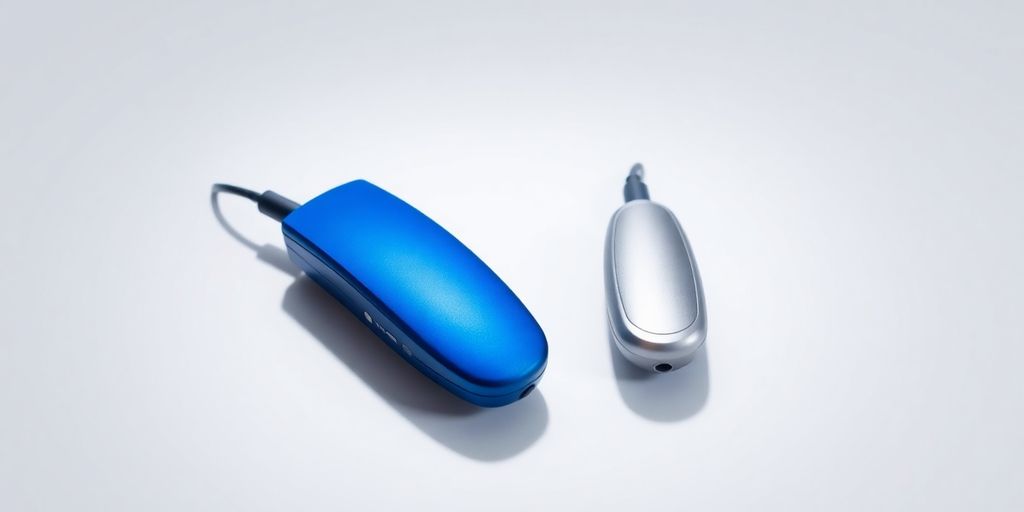Parasym vs Pulsetto: A Comprehensive Comparison of Vagus Nerve Stimulation Devices for 2025

So, you’re looking into vagus nerve stimulation devices, huh? It’s a pretty hot topic right now, especially with all the talk about improving well-being. We’re going to break down two popular options, Parasym and Pulsetto, to help you figure out which one might be a good fit for you. Think of this as your friendly guide to understanding these devices and what makes them tick, so you can make a smart choice for 2025.
Key Takeaways
- Parasym’s Nurosym has regulatory approvals like the CE Mark and FDA Non-Significant Risk status, showing its safety and effectiveness.
- Don’t mess with DIY electrical current devices for your nervous system; they can really mess things up. Nurosym has been used in over 2 million sessions without serious problems.
- Nurosym’s patented waveform, developed over 8 years and costing more than $10 million, is designed to properly stimulate the vagus nerve.
- Parasym’s technology is backed by over 30 peer-reviewed studies, making it the most studied non-invasive VNS device out there.
- Nurosym targets the left ear tragus, stimulating specific nerves to activate the parasympathetic nervous system, which is important for rest and recovery. Uncertified neck devices might hit the wrong nerves and cause issues.
Understanding Vagus Nerve Stimulation
The Science Behind Vagus Nerve Stimulation
Okay, so the vagus nerve. It’s a big deal. Think of it like the body’s main information highway, running from your brain all the way down to your gut. It’s not just one thing; it’s a complex system that affects a ton of stuff, like your heart rate, digestion, and even your mood. When it’s working right, everything’s generally smoother. When it’s not, well, that’s when problems can start popping up. Stimulating this nerve can help get things back on track.
Invasive Versus Non-Invasive Approaches
There are a couple of ways to stimulate the vagus nerve. The old-school way is invasive. This means surgery. They actually implant a device, kind of like a pacemaker, that sends electrical pulses to the nerve. It’s effective, but it’s also a pretty big deal, with risks and recovery time. The newer way is non-invasive. No surgery needed! These devices usually stimulate the nerve through the skin, often on the ear or neck. It’s way less risky and more convenient, but the effectiveness can vary.
Health Conditions Addressed by Vagus Nerve Stimulation
So, what’s all this stimulation good for? Turns out, quite a bit. Vagus nerve stimulation has been used for things like:
- Epilepsy
- Depression
- Anxiety
- Chronic pain
It’s also being explored for other conditions, like heart problems and even some autoimmune diseases. The idea is that by stimulating the vagus nerve, you can help regulate the nervous system and reduce inflammation, which can have a positive effect on a wide range of health issues.
Vagus nerve stimulation is showing promise in treating a variety of conditions, but it’s not a magic bullet. It’s important to talk to your doctor to see if it’s right for you and to understand the potential risks and benefits.
Parasym’s Nurosym: A Deep Dive
Pioneering Non-Invasive Technology
Parasym has really been at the forefront of non-invasive neuromodulation with the Nurosym. This system uses transcutaneous auricular vagus nerve stimulation (tVNS), which is a fancy way of saying it stimulates the vagus nerve through the skin of your ear. The Nurosym device sends precise, patented microcurrent electrical impulses via the tragus of the left ear. These impulses then travel to the brain stem, activating the parasympathetic nervous system.
This activation can lead to some good stuff, like decreased inflammation, reduced stress, and better sleep. It’s pretty cool how it all connects.
Targeted Stimulation for Optimal Effectiveness
One of the things that sets Nurosym apart is its targeted approach. Instead of just zapping anywhere, it specifically targets the left ear tragus. This area is rich in vagus nerve connections, which means the stimulation is more effective. This targeted stimulation ensures optimal effectiveness throughout the entire nervous system.
Clinical Validation and Research Backing
Nurosym isn’t just some gadget; it’s backed by science. It’s a clinically-validated, CE-certified device and has even received multiple designations of non-significant risk from the FDA in the US. That’s a lot of acronyms, but basically, it means it’s been tested and found to be safe and effective. Plus, it’s indicated for things like depression, anxiety, insomnia, and pain. There have been clinical trials using Nurosym technology that show promising results in other areas too, like long-COVID, POTS, autoimmune, and cardiovascular diseases. All of these are often linked to dysautonomia. Ongoing research keeps suggesting more ways Nurosym tech could help with different medical issues.
Here’s a quick rundown of some key findings:
- Significant improvement in fatigue scores
- Reduction in depression scale scores after treatment
- Lower increase in heart rate upon standing (for POTS patients)
Key Features of Vagus Nerve Stimulation Devices
Non-Invasive Nature and Ease of Use
One of the biggest draws to modern vagus nerve stimulation (VNS) is how easy it is to use. Forget surgery! Non-invasive devices let you stimulate the vagus nerve without any implants. This means less risk and a much easier experience. Think about it: no hospital stays, no anesthesia, and no recovery time. It’s a game-changer for people who want to manage their health conditions without invasive procedures.
Adjustability of Stimulation Parameters
The ability to adjust stimulation parameters is super important. Different people need different levels of stimulation, and the best devices let you fine-tune things like frequency and intensity. This way, you can find the settings that work best for you and your specific needs. It’s all about personalizing your therapy for optimal results.
Portability and Lifestyle Compatibility
Modern VNS devices are designed to fit into your life, not the other way around.
Here’s what that looks like:
- Small and lightweight designs.
- Long battery life for on-the-go use.
- Discreet operation so you can use them anywhere.
VNS devices are becoming more and more integrated into daily life. You can use them while working, relaxing, or even exercising. This makes it easier to stick with your therapy and get the most out of it.
With the right device, you can manage conditions like chronic fatigue and improve your overall well-being without disrupting your routine.
Choosing the Right Vagus Nerve Stimulation Device

So, you’re thinking about getting a vagus nerve stimulation (VNS) device? It’s a big decision! There are a few things you really need to consider before you jump in. It’s not like buying a new phone; this is about your health and well-being. Let’s break down some key points to help you make the right choice.
Evaluating Medical Device Certifications
Okay, first things first: certifications. Don’t just go for something with a basic manufacturing certificate, like an FCC certificate. You want to see some clinical assessment of safety. Look for devices that have gone through rigorous testing and have the proper medical certifications. For example, the Nurosym has a CE Mark in the EU and FDA Non-Significant Risk designation in studies. That kind of stuff matters.
Avoiding Untested Electrical Current Devices
Seriously, stay away from DIY electrical current devices. I know, I know, the internet is full of crazy stuff, but messing with your nervous system using something untested is a terrible idea. You could end up doing some serious damage. We’re talking potentially irreversible damage. Devices like Nurosym have millions of treatment sessions under their belt with minimal reported issues. That’s the kind of track record you want.
Importance of Regulatory Approvals
Regulatory approvals are a big deal. It means the device has been vetted and approved by the proper authorities. Nurosym, for instance, has demonstrated in clinical studies that it stimulates the vagus nerve using a patented waveform. This waveform was developed over eight years of lab research and cost over $10 million. That’s a serious investment in safety and effectiveness. Don’t skimp on this, folks.
Choosing a VNS device isn’t just about finding something that seems cool or trendy. It’s about making an informed decision based on safety, clinical validation, and regulatory approval. Your health is worth the extra research and careful consideration.
Parasym vs Pulsetto: Scientific Foundation
Parasym’s Extensive Peer-Reviewed Studies
When considering vagus nerve stimulation devices, it’s important to look at the science backing them. Parasym stands out because their technology is the most studied non-invasive VNS device available. They have over 30 peer-reviewed research studies that validate how well it works. This is a big deal because it means scientists have tested and confirmed that the device does what it claims to do. These studies give users confidence that they’re using a device with a solid scientific base. The Nurosym device has been tested in many clinical trials.
Randomized Placebo-Controlled Clinical Trials
To really know if a device is effective, you need randomized placebo-controlled clinical trials. These trials help show whether the benefits come from the device itself or from the placebo effect. Parasym has worked with over 60 research partners and has proven that their device activates the parasympathetic nervous system better than a placebo. This means the device’s effects aren’t just in people’s heads; it actually changes how their bodies work. This is a key factor when choosing a VNS device. The Pulsetto wearable device is another option to consider.
Patented Waveform Development and Investment
Parasym has invested a lot in developing their technology. They’ve spent over $10 million and eight years in the lab to create a patented waveform for their device. This waveform is designed to stimulate the vagus nerve effectively. This level of investment and research shows that Parasym is serious about creating a high-quality, scientifically sound product. It’s not just about making a device; it’s about making one that works well and is based on solid science.
It’s important to remember that not all VNS devices are created equal. Look for devices with strong scientific backing, like Parasym, to ensure you’re getting a product that’s been proven to work.
Impact on Stress and Heart Rate Variability

Vagus Nerve Stimulation for Stress Reduction
Stress can really mess with your body, and it’s not just in your head. Vagus nerve stimulation (VNS) is emerging as a method to help manage stress. The vagus nerve plays a big role in the parasympathetic nervous system, which helps calm you down. By stimulating this nerve, devices like Nurosym and Pulsetto aim to reduce the physical symptoms of stress. Some studies even suggest that VNS can help with stress-related psychiatric issues. It’s not a cure-all, but it could be a useful tool in managing daily stress. vagus nerve stimulation can be a great way to mitigate stress.
Improving Heart Rate Variability with Nurosym
Heart Rate Variability (HRV) is a measure of the variation in time between each heartbeat. Higher HRV is generally a sign of better cardiovascular health and resilience to stress. Nurosym, a VNS device, is designed to improve HRV by stimulating the vagus nerve. This stimulation helps to balance the activity of the sympathetic and parasympathetic nervous systems, leading to a more adaptable and responsive heart. Think of it like tuning your body’s engine to run more smoothly.
Balancing Sympathetic and Parasympathetic Activity
The sympathetic nervous system is responsible for the "fight or flight" response, while the parasympathetic nervous system handles "rest and digest" functions. Ideally, these two systems should be in balance. Chronic stress can throw this balance off, leading to a constantly activated sympathetic system. Vagus nerve stimulation helps to restore this balance by boosting parasympathetic activity. This can lead to a reduction in heart rate, blood pressure, and overall feelings of anxiety.
Imagine your body as a car. The sympathetic system is the gas pedal, and the parasympathetic system is the brake. If you’re constantly hitting the gas, the engine will overheat. Vagus nerve stimulation helps you tap the brakes, allowing the engine to cool down and run more efficiently.
Safety and Professional Guidance
Minimal Side Effects of Certified tVNS
When you’re thinking about using any kind of nerve stimulation, safety is a big deal. With certified transcutaneous vagus nerve stimulation (tVNS) devices, like the Nurosym, the good news is that serious side effects are rare. Most people don’t experience anything beyond mild skin irritation where the device touches their skin. It’s kind of like when you wear a new watch too tight – a little redness that goes away quickly. The key is to stick with devices that have gone through rigorous testing and have the right certifications.
Consulting Healthcare Professionals
Before you jump into using any vagus nerve stimulation device, chat with your doctor. Seriously. They know your medical history and can tell you if it’s a good fit for you. It’s not about being overly cautious; it’s about being smart. Your doctor can also help you figure out the right settings and how often to use the device. Think of it like getting a personal trainer for your vagus nerve – they’ll help you get the most out of it safely. Plus, they can keep an eye out for any potential interactions with medications you’re already taking. It’s always better to be safe than sorry.
Parasym’s Medical Advisory Team
Parasym, the company behind Nurosym, has a whole team of medical experts who guide their work. This isn’t just some tech company throwing a device out there; they’ve got doctors and scientists making sure everything is safe and effective. This team helps design the device, reviews the research, and provides guidance on how to use it properly. Knowing there’s a medical advisory team involved gives you extra confidence that you’re using a device backed by real medical knowledge.
It’s important to remember that while tVNS is generally safe, it’s not a one-size-fits-all solution. What works for one person might not work for another, and it’s crucial to listen to your body and work with healthcare professionals to find the best approach for you.
Here are some things to keep in mind:
- Start slow: Don’t crank up the stimulation right away. Give your body time to adjust.
- Pay attention to your body: If you feel any discomfort, stop using the device and talk to your doctor.
- Read the instructions: Seriously, don’t skip this step. It’s there for a reason.
Conclusion
So, when you look at Parasym and Pulsetto for 2025, it’s clear there’s a lot to think about. Both devices aim to help your vagus nerve, but they do it in different ways. Parasym, with its Nurosym device, really leans into the science, showing lots of studies and focusing on precise stimulation. They talk a lot about how their device has been tested and approved, and how it targets the right spots. Pulsetto, on the other hand, might appeal more to folks looking for something simple and easy to use in their daily life. Ultimately, picking the right one comes down to what you need. Do you want something with a ton of research behind it, or something that fits easily into your routine? It’s a personal choice, and hopefully, this comparison helps you figure out which device makes the most sense for you.
Frequently Asked Questions
What is vagus nerve stimulation (VNS)?
Vagus nerve stimulation (VNS) is a way to gently activate the body’s longest nerve, the vagus nerve. This nerve helps control many important body functions, like heart rate, digestion, and mood. By sending small electrical signals to this nerve, VNS can help improve how these systems work, leading to better health and well-being.
Why is the vagus nerve important?
The vagus nerve is like a major highway in your body, connecting your brain to many important organs, including your heart, lungs, and gut. It plays a big role in your “rest and digest” system, helping you calm down after stress and keeping your body balanced. When this nerve works well, it helps you feel good and stay healthy.
What are the different types of VNS?
There are two main kinds: invasive and non-invasive. Invasive VNS involves a surgery to put a small device inside your body, usually for serious conditions like epilepsy. Non-invasive VNS, like Parasym’s Nurosym, uses a device placed on the skin, often on the ear, to send signals without surgery. Non-invasive methods are safer and easier to use.
How does Parasym’s Nurosym work?
Parasym’s Nurosym is a special non-invasive device that sends gentle electrical pulses to a specific part of your ear, which is connected to the vagus nerve. These pulses help calm your nervous system, reduce stress, improve sleep, and can even help with things like chronic pain and anxiety. It’s designed to be easy to use and fit into your daily life.
What should I look for in a VNS device?
When choosing a VNS device, it’s super important to pick one that’s safe and actually works. Look for devices that have been approved by health authorities, like the CE Mark or FDA. Also, check for devices that have been studied in real clinical trials, especially those that compare the device to a fake one (placebo) to prove it’s effective. Avoid any DIY or uncertified devices, as they can be risky.
Is VNS safe, and should I talk to a doctor before using it?
While non-invasive VNS like Nurosym is generally safe and has very few side effects, it’s always a good idea to talk to a doctor or healthcare professional before you start using any new medical device. They can help you figure out if VNS is right for you and make sure it fits with your health needs.








Responses